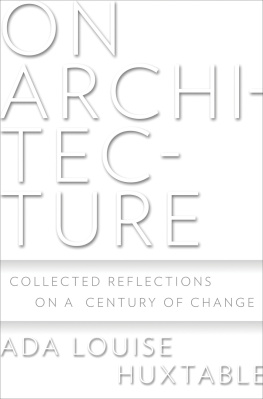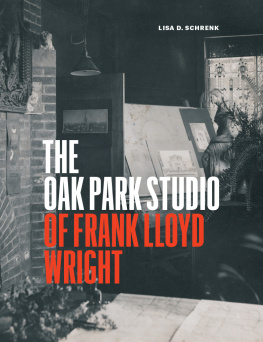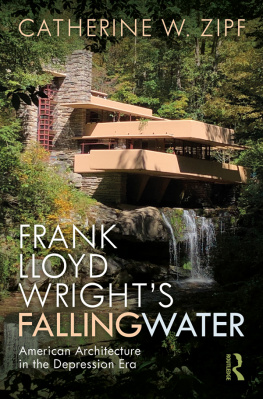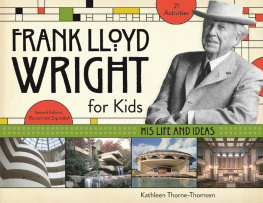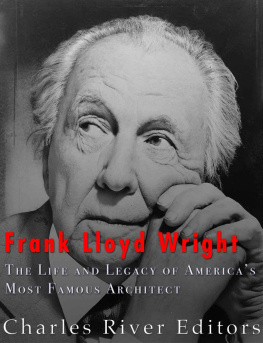Praise for Ada Louise Huxtables
Frank Lloyd Wright
A fine and unsparing appreciation of an American original.
Kirkus Reviews
They are all here, those eye-popping events that make Frank Lloyd Wright so appealing.... Insightful, thought-provoking and readable... The eventfulness of the extraordinary life and the refreshing intelligence and craft of the author make this a pleasure to read.
The New York Times Book Review
Stimulating... Engaging... With its dollop of sizzle, this fluently written biography will provoke renewed interest in Wrights architecture among general readers.
Publishers Weekly
Ms. Huxtable won me to her side immediately.
The New York Sun
An ideal match: Ada Louise Huxtable, the finest architecture critic the United States has, takes on the willful visionary [Frank Lloyd Wright].
San Francisco Chronicle
Alive.
The Boston Globe
[Huxtable is] one of the leading architectural journalists of our time.... It is fitting that her extensive experience on the American architecture scene has been brought to bear on the life and work of its most famous architect.
Chicago Tribune
Enlightened. The New York Review of Books
As readers of Huxtables Pulitzer Prize-winning criticism know, she is a discerning writer fluent in architectural thought and practice.... Comfortable with ambiguity and complexity, Huxtable not only parses both key events and overlooked subtleties, she also wrestles with the prickly questions about character and creativity raised by the contrast between Wrights self-serving, tyrannical behavior and his enormously influential achievements.
Booklist
PENGUIN BOOKS
FRANK LLOYD WRIGHT
Ada Louise Huxtable, former New York Times critic, winner of the first Pulitzer Prize for Distinguished Criticism, and MacArthur Fellow, is currently the architecture critic for the Wall Street Journal. Her books include The Unreal America: Architecture and Illusion, Kicked a Building Lately? and, most recently, On Architecture: Collected Reflections on a Century of Change. She served for many years on the juries of the Pritzker Architecture Prize and the American Committee of the Japanese Praemium Imperiale. She lives in New York City and Marblehead, Massachusetts.
ADA LOUISE HUXTABLE
Frank Lloyd Wright
A Life

PENGUIN BOOKS
Published by the Penguin Group
Penguin Group (USA) Inc., 375 Hudson Street, New York, New York 10014, U.S.A. Penguin Group (Canada), 90 Eglinton Avenue East, Suite 700, Toronto, Ontario, Canada M4P 2Y3 (a division of Pearson Penguin Canada Inc.) Penguin Books Ltd, 80 Strand, London WC2R 0RL, England Penguin Ireland, 25 St Stephens Green, Dublin 2, Ireland (a division of Penguin Books Ltd) Penguin Group (Australia), 250 Camberwell Road, Camberwell, Victoria 3124, Australia (a division of Pearson Australia Group Pty Ltd) Penguin Books India Pvt Ltd, 11 Community Centre, Panchsheel Park, New Delhi - 110 017, India Penguin Group (NZ), 67 Apollo Drive, Rosedale, North Shore 0632, New Zealand (a division of Pearson New Zealand Ltd) Penguin Books (South Africa) (Pty) Ltd, 24 Sturdee Avenue, Rosebank, Johannesburg 2196, South Africa
Penguin Books Ltd, Registered Offices: 80 Strand, London WC2R 0RL, England
First published in the United States of America by Viking Penguin,
a member of Penguin Group (USA) Inc. 2004
Published in Penguin Books 2008
Copyright Ada Louise Huxtable, 2004
All rights reserved
Grateful acknowledgment is made for permission to reprint excerpts from An
Autobiography by Frank Lloyd Wright. Copyright 1943, 1999 The Frank Lloyd Wright
Foundation, Scottsdale, Arizona. All rights reserved. Used by permission.
Photograph on page 85 Pedro E. Guerrero. All other photographs courtesy The Frank Lloyd Wright Archives, Taliesin West, Scottsdale, Arizona.
ISBN: 978-1-4406-3173-3
1. Wright, Frank Lloyd, 1867-1959. 2. ArchitectsUnited StatesBiography. I. Title. II. Penguin lives series. NA737.W7H.92dc22 2004046477
The scanning, uploading and distribution of this book via the Internet or via any other means without the permission of the publisher is illegal and punishable by law. Please purchase only authorized electronic editions, and do not participate in or encourage electronic piracy of copyrighted materials. Your support of the authors rights is appreciated.
http://us.penguingroup.com
Contents
Preface and Acknowledgments
THE ROUTE to this book has been long and indirect. The project began during a privileged year that I spent as a Directors Fellow at the Dorothy and Lewis B. Cullman Center for Scholars and Writers at the New York Public Library, with the sympathetic encouragement of its founding director, Peter Gay, an experience and opportunity for which I am extremely grateful. Frank Lloyd Wright was not the subject of my fellowship. I was investigating a new and radical kind of architecture based on the use of the computer as a design and production tool, and while I learned a great deal that I needed to know, in a curious way it led me back to an unfinished study on Wright started many years earlier.
I became aware of amazing parallels between Wrights work and the most advanced computer-generated design of todays tech-savvy young architects. Both invented new solutions based on a radical vision and a fascination bordering on obsession with the generating capabilities of geometry. Both pushed inventive fantasy to its limits within the possibilities open to them. They shared the same adventurous mind-set, intent on redefining what architecture can do and how it should look. But Wright did it the old-fashioned way, with straightedge, T square, compass, and triangle, everything hand-drawn; he worked with the circles, squares, triangles, and hexagons of solid geometry and the patterns of crystallography. Todays architects, using advanced computer programs, have moved on to fractals and calculus and infinite computational variations for virtually unrestricted shapes and forms. Wrights most important tools were the power of his imagination and his aesthetic sensibilities. Seen in the context of what is happening in architecture in the twenty-first century, his work takes on new significance and meaning.
I continued my research in the librarys Frederick Lewis Allen Room the next year, grateful for the hospitality of this treasured writers sanctuary graciously dispensed by Wayne Furman, and the advantage of the librarys art and architecture collections and its enormously helpful staff. The material was organized during a stay at the Medway Plantation in South Carolina, a writers retreat of stimulating intellectual companionship and sybaritic pleasures, for which I thank its generous guiding spirit, Bokhara Legendre. My constant companions were the boxes of books that traveled with me.
Among those books, the sources I relied on most represent the smallest fraction of the publications on Wright. The bibliography is so large and so accessiblethere are books devoted to the Wright bibliography alonethat I am listing only those references that I have found of most recent interest and enduring value for my purposes. An indispensable work was Meryle Secrests biography Frank Lloyd Wright (New York: Knopf, 1992) for its admirably researched account of Wrights life and the new information it added. Brendan Gills Many Masks: A Life of Frank Lloyd Wright (New York: Ballantine, 1987) also provided helpful material. Robert C. Twomblys


